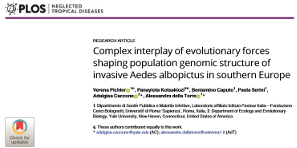Publication: Complex interplay of evolutionary forces shaping population genomic structure of invasive Aedes albopictus in southern Europe

Studying the genomes of invasive populations allows for the tracing of invasion processes. In this study, the authors have focused on the invasion of Albania, Italy and Greece by the Asian tiger mosquito,Aedes albopictus' one of the most successful invasive animal species worldwide.
In the last 40 years has invaded all continents resulting from the transportation of its eggs via human induced dispersion, especially the international used tire trades. Results showed that the invasion process was triggered by multiple independent (and most likely ongoing) importations of large number of eggs from different continents. Afterward, ground transportation of adult mosquitoes (e.g. by cars and trucks) and the capacity of the species to adapt to novel environmental conditions have allowed the colonization of whole countries, as clearly shown to have occurred in Italy. Overall, the results are consistent with a major role of human activities in the extraordinary expansion of the species, which today can be considered a permanent pest in all Mediterranean European countries, where it has already caused the infections of Europeans with exotic viruses (such as chikungunya) once confined to tropical regions and today representing a major concern also in temperate regions.
The paper published in PLOS Neglected Tropical Diseases and written by Pichler et al can be viewed in full here...
Citation: Pichler V, Kotsakiozi P, Caputo B, Serini P, CacconeA, della TorreA (2019) Complex interplay of evolutionary forces shapingpopulation genomic structure of invasive Aedes albopictusin southern Europe.PLoS Negl Trop Dis 13(8): e0007554. https://doi.org/10.1371/journal.pntd.0007554
For a full list of publications by AIM-COST partners and others recommended by partners can be found here...

